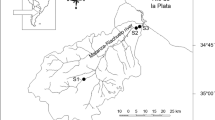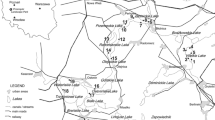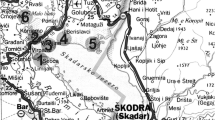Abstract
In the present study, the concentrations of trace and alkali metals in leaves of four common helophytes, Sparganium erectum, Glyceria maxima, Phalaris arundinacea, and Phragmites australis, as well as in corresponding water and bottom sediments were investigated to ascertain plant bioaccumulation ability. Results showed that Mn and Fe were the most abundant trace metals in all plant species, while Co and Pb contents were the lowest. Leaves of species studied differed significantly in respect of element concentrations. The highest concentrations of Mg, Na, Fe, Mn, Cu, Pb, and Ni were noted in S. erectum while the highest contents of Co, Ca, Zn, and Cr in Phalaris arundinacea. Phragmites australis contained the lowest amounts of most elements. Concentrations of Co, Cr, Fe, and Mn in all species studied and Ni in all except for Phragmites australis were higher than natural for hydrophytes. The leaves/sediment ratio was more than unity for all alkali metals as well as for Cu and Mn in Phragmites australis; Cr, Co, and Zn in Phalaris arundinacea; Cr and Mn in S. erectum; and Cr in G. maxima. High enrichment factors and high levels of toxic metals in the species studied indicated a special ability of these plants to absorb and store certain non-essential metals and, consequently, their potential for phytoremediation of contaminated aquatic ecosystems.


Similar content being viewed by others
References
Aksoy A, Duman F, Sezen G (2005) Heavy metal accumulation and distribution in narrow-leaved cattail (Typha angustifolia) and common reed (Phragmites australis). J Freshw Ecol 20:783–785
Baldantoni D, Alfani A, Di Tommasi P, Bartoli G, De Santo AV (2004) Assessment of macro and microelement accumulation capability of two aquatic plants. Environ Pollut 130:149–156
Barker AV, Pilbeam DJ (2007) Handbook of plant nutrition. CRC Taylor and Francis, Boca Raton, London, New York
Bonanno G (2011) Trace element accumulation and distribution in the organs of Phragmites australis (common reed) and biomonitoring applications. Ecotoxicol Environ Saf 74:1057–1064
Bonanno G (2013) Comparative performance if trace element bioaccumulation and biomonitoring in the plant species Typha domingensis, Phragmites australis and Arundo donax. Ecotoxicol Environ Saf 97:124–130
Bonanno G, Lo Giudice R (2010) Heavy metal bioaccumulation by the organs of Phragmites australis (common reed) and their potential use as contamination indicators. Ecol Indic 10:639–645
Boyd CE (1995) Bottom soils, sediment, and pond aquaculture. Chapman & Hall, New York
Branković S, Pavlović-Muratspahić D, Topuzović M, Glisić R, Banković D, Stanković M (2011) Environmental study of some metals on several aquatic macrophytes. Afr J Biotechnol 10:11956–11965
Brooks RR, Robinson BH (1998) Aquatic phytoremediation by accumulator plants. In: Brooks RR (ed) Plants that hyperaccumulate heavy metals: their roles in phytoremediation, microbiology, archaeology, mineral exploration and phytomining, Oxon, CAB International, 203–226
Chatterjee J, Chatterjee C (2000) Phytotoxicity of cobalt, chromium and copper in cauliflower. Environ Pollut 109:69–74
Coby SCW, Xiangdong L, Iain T (2006) Urban environmental geochemistry of trace metals. Environ Pollut 142:1–16
Dojlido JR (1995) Chemistry of surface water. Wydawnictwo Ekonomia i Środowisko Białystok, Polish
Du Laing G, Van de Moortel AMK, Moors W, De Grauwe P, Meers E, Tack FMG, Verloo MG (2009) Factors affecting metal concentrations in reed plants (Phragmites australis) of intertidal marshes in the Scheldt estuary. Ecol Eng 35:310–318
Eid EM, Kamal HS, El-Sheikh MA, Takashi A (2012) Seasonal courses of nutrients and heavy metals in water, sediment and above- and below-ground Typha domingensis biomass in Lake Burullus (Egypt): perspectives for phytoremediation. Flora 207:783–794
Fawzy MA, El-sayed Badr N, El-Khatib A, Abo-El-Kassem A (2012) Heavy metal biomonitoring and phytoremediation potentialities of aquatic macrophytes in River Nile. Environ Monit Assess 184:1753–1771
Kabata-Pendias A (2004) Soil–plant transfer of trace elements—an environmental issue. Geoderma 122:143–149
Kabata-Pendias A, Pendias H (2001) Trace elements in soils and plants. CRC Press, Boca Raton
Kamel KA (2013) Phytoremediation potentiality of aquatic macrophytes in heavy metal contaminated water of El-Temsah Lake, Ismailia, Egypt. Middle-East J Sci Res 14:1555–1568
Karczewska A, Bortniak M (2008) Chromium and other heavy metals in soils in the area of Wrocław water infiltration fields in the vicinity of ferrochromic slag dump in Siechnice. Roczniki Gleboznawcze LIX:106–111
Klink A, Krawczyk J, Wisłocka M (2009) The content of heavy metals in leaves of Phragmites australis (Cav.) Trin. Ex Steud. and bottom sediments from lakes of Pojezierze Leszczyńskie. Ochrona Środowiska i Zasobów Naturalnych 39:60–66
Klink A, Stankiewicz A, Wisłocka M, Polechońska L (2014) Macro- and microelement distribution in organs of Glyceria maxima and biomonitoring applications. Environ Monit Assess 186:4057–4065
Krzemińska A, Medwecka-Szklanna M, Dzikowska A, Wawrzyniak P (2010) Ecomorphological valorization of the Oława River from km 01 + 400 to 04 + 800. Infrastruct Ecol Rural Areas 8:65–77 (in Polish)
Kumari M, Tripathi BD (2015) Efficiency of Phragmites australis and Typha latifolia for heavy metal removal from wastewater. Ecol Environ Saf 112:80–86
Kurilenko VV, Osmolovskaya NG (2006) Ecological–biogeochemical role of macrophytes in aquatic ecosystems of urbanized territories (an example of small water bodies of St. Petersburg). Russ J Ecol 37:147–151
Kuusisto-Hjort P, Hjort J (2013) Land use impacts on trace metal concentrations of suburban stream sediments in the Helsinki region, Finland. Sci Total Environ 456–457:222–223
Legendre P, Legendre L (1998) Numerical ecology. Developments in environmental modelling, Amsterdam
Markert B (1992) Presence and significance of naturally occurring chemical elements of the periodic system in the plant organism and consequences for future investigations on inorganic environmental chemistry in ecosystems. Vegetatio 103:1–30
Matache ML, Marin C, Rozylowicz L, Tudorache A (2013) Plants accumulating heavy metals in the Danube River wetlands. J Environ Health Sci Eng 11:39
Marchand L, Nsanganwimana F, Cook BJ, Vystavna Y, Huneau F, Le Coustumer P, Lamy JB, Oustrière N, Mench M (2014) Trace element transfer from soil to leaves of macrophytes along the Jalle d’Eysines River, France and their potential use as contamination biomonitors. Ecol Indic 46:425–437
Parzóch K, Solarska A (2008) Anthropogenic reconstruction of valley bottom in foreland of Sudety Mts. for example Oława and Krynka. Landform Anal 9:314–318 (in Polish)
Polechońska L, Klink A (2014) Trace metal bioindication and phytoremediation potentialities of Phalaris arundinacea L. (reed canary grass). J Geochem Explor 146:27–33
Salem ZB, Laffray X, Ashoour A, Ayadi H, Aleya L (2014) Metal accumulation and distribution in the organ of reeds and cattails in a constructed treatment wetland (Etueffont, France). Ecol Eng 64:1–17
Samecka-Cymerman A, Kempers AJ (2001) Concentrations of heavy metals and plant nutrients in water, sediments and aquatic macrophytes of anthropogenic lakes (former open cut brown coal mines) differing in stage of acidification. Sci Total Environ 281:87–98
Silva-Filho EV, Marques ED, Vila M, Gomes OVO, Sanders CJ, Kutter VT (2014) Distribution of trace metals in stream sediments along the Trans-Amazonian Federal Highway, Para State, Brazil. J S Am Earth Sci 54:182–195
Sharma S, Singh B, Manchanda VK (2015) Phytoremediation: role of terrestrial plants and aquatic macrophytes in the remediation of radionuclides and heavy metal contaminated soil and water. Environ Sci Pollut Res 22:946–962
Stanisławska M, Marlinga J, Nowak P, Kaniewski R (2004) Environment programme for Oława. Investment Management Environment Consulting, Polish
StatSoft Inc. (2011) Statistica (data analysis software system), version 10. www.statsoft.com
Stoltz E, Greger M (2002) Accumulation properties of As, Cd, Cu, Pb and Zn by four wetland plant species growing on submerged mine tailings. Environ Exp Bot 47:271–280
Šumberová K (2011) MCA Phragmition australis Koch 1926. In: Chytrý M (ed) Vegetation of the Czech Republic 3. Aquatic and wetland vegetation. Academia, Praha, pp 391–394
Teuchies J, Jacobs S, Oosterlee L, Bervoets L, Meire P (2013) Role of plants in metal cycling in a tidal wetland: implications for phytoremediation. Sci Total Environ 445–446:146–154
Wang Z, Yao L, Liu G, Liu W (2014) Heavy metals in water, sediments and submerged macrophytes in ponds around the Dianchi Lake, China. Ecotoxicol Environ Saf 107:200–206
Woitke P, Wellmitz J, Helm D, Kube P, Lepom P, Litheraty P (2003) Analysis and assessment of heavy metal pollution in suspended solids and sediments of the river Danube. Chemosphere 51:633–642
Vardanyan LG, Ingole BS (2006) Studies on heavy metal accumulation in aquatic macrophytes from Sevan (Armenia) and Carambolim (India) lake system. Environ Int 32:208–218
Vymazal J, Sveha J (2012) Removal of alkali metals and their sequestration in plants in constructed wetlands treating municipal sewage. Hydrobiologia 692:131–143
Zar J (1999) Biostatistical analysis. Prentice Hall, New Jersey
Acknowledgments
Conflict of interest
The authors declare that they have no conflict of interest.
Author information
Authors and Affiliations
Corresponding author
Additional information
Responsible editor: Elena Maestri
Rights and permissions
About this article
Cite this article
Łojko, R., Polechońska, L., Klink, A. et al. Trace metal concentrations and their transfer from sediment to leaves of four common aquatic macrophytes. Environ Sci Pollut Res 22, 15123–15131 (2015). https://doi.org/10.1007/s11356-015-4641-1
Received:
Accepted:
Published:
Issue Date:
DOI: https://doi.org/10.1007/s11356-015-4641-1




